
 The school that the children attend, Windhoek International School (WIS), held its annual International Day this past Saturday; the purpose of which is to celebrate the international nature of the school. So all of the names of the countries from which the students hail were put into a hat and each of the class sections selected a country by having a representative pull a slip out of the hat. Augustus’ class got Argentina. Emma’s got Italy and Annie’s received Mozambique. Each class then was responsible for transforming the classroom into “their country” for the day. The display included photos of monuments, landmarks, geographic features or any artifact typically associated with the place. Also, many of the kids dressed in the traditional dress of “their country”. Additionally, because this is also a fund raiser, the class sold food and drink typical of the country. There were also activities to go along with each venue. Some classes performed various folk dances for the crowd in the courtyard as well.
The school that the children attend, Windhoek International School (WIS), held its annual International Day this past Saturday; the purpose of which is to celebrate the international nature of the school. So all of the names of the countries from which the students hail were put into a hat and each of the class sections selected a country by having a representative pull a slip out of the hat. Augustus’ class got Argentina. Emma’s got Italy and Annie’s received Mozambique. Each class then was responsible for transforming the classroom into “their country” for the day. The display included photos of monuments, landmarks, geographic features or any artifact typically associated with the place. Also, many of the kids dressed in the traditional dress of “their country”. Additionally, because this is also a fund raiser, the class sold food and drink typical of the country. There were also activities to go along with each venue. Some classes performed various folk dances for the crowd in the courtyard as well.Augustus dressed in a poncho and broad brimmed hat complete with mustache. Some of his classmates performed the tango (they’ve been taking private lessons and even dressed for the part). Emma’s class sold pizza of course and had spaghetti mosaics for an activity. They performed the “tarantella” which her little classmate referred to as the “tarantula”. Emma actually did the moves and didn’t try to hide behind friends as she is apt to do. I made a slide show for the class from the photos of my 2006 Europe trip. Annie’s classroom was decorated like a beach scene complete with bar that sold actual cocktails and beer. Tristan’s class, the son of the Fulbrighter family with whom we often pal around, sold White Russians and shots. We thought that Louisiana took a laissez-faire attitude with regard to alcohol consumption, huh, little did we know. However, no kids seemed to try to partake in the imbibing that was transpiring. They seemed to know the limitations, but there were a few happy adults.
Despite that bit of a cultural adjustment, it was indeed a wonderful day and the displays were really well thought out. Everyone worked very hard to make it a success and we enjoyed it thoroughly. This was especially poignant given that the Festival International was taking place in Lafayette, Louisiana which we so love attending every year, at the very same time.







